Introduction
On Nov. 1997, Korea faced the IMF crisis, or also known as the financial crisis, which caused severe damage to the Korean economy. The new OECD member was reduced from being the world’s eleventh largest economy to an economy surviving on overnight loans from the international money markets. The won, the Korean currency, fell by more than 50 percent against the US dollar. Also, KOSPI (the Korea Composite Stock Price Index) fell by thirty percent, and the short-term interest rate shot up to forty percent per year. Consequently, on Dec. 1997, Korea called the IMF for rescue, owing $58.3 billion of financial aid. As shown in table 1 and 2 in the appendix 1, Korea had performed continual rapid GDP growth at the rate of 7.8 percent per year in average from 1960 to 1997. Then, what had happened to Korea, and why did the nation have to face the IMF crisis in 1997 all of a sudden? To see what the causes for the crisis were, analyses from six essays of scholars and experts in the field of economics will be introduced and compared. While they have similar and different views for the causes at the same time, their views can be grouped into two categories: internal factors and external factors. When the Korean currency crisis broke out, the IMF and many scholars focused the whole crisis on Korea’s internal problems. However, there are many other scholars who attribute the causes not only to internal but also to external problems. The experts who see the causes as internal problems think the crisis originated from internal factors of Korea such as policy mistakes, highly leveraged corporate sectors, and banking system. The external factors refer to the external shocks such as contagion effect from South-east financial crisis and appreciation of Japanese yen. Although all the causes for the crisis are closely related with each other, addressing the causes separately would give people better understanding of the context.
Ⅰ. Internal Factors
While only a few writers of the essays this paper refers to attribute the crisis to external factors, all the writers agree that internal factors have responsibility for the crisis. The internal factors they have raised are plenty. One thing to notice is that each of the internal factors is referred to particular reference. To clearly state, the factors are referred to as follows: Korean banks’ structurally unsound method of lending money ([6]); the structural weaknesses in the government-bank relationship ([1], [2], [3], [4] and [5]); a highly leveraged corporate sector ([1], [3], [4] and [5]); the development of the high-cost and low-profit economy ([5]); macroeconomic developments before the crisis ([4]); and finally, policy mistakes ([2], [3] and [4]). What kind of negative effects would have these factors brought to the Korean economy?
Korean Banks’ Structurally Unsound Method of Lending Money
Kim, the author of The New Korea an Inside Look at South Korea’s Economic Rise [6], expresses the Korean banks’ method of lending money as, “THEY DON’T EVALUATE, THEY JUST LEND.” According to Kim, one must understand the scope of the economic growth that occurred in Korea for the previous thirty years in order to understand why such a method was dominant. Since the early 1960s, Korea had averaged between 6 and 8 percent annual growth. To support such rapid growth, the country had settled on a system of low-interest loans from banks to the industrial sector. The banks could give low-interest loans to companies on a permanent basis because of guarantees provided by the government. The government used loan guarantees to control and direct the manufacturing industry.
A few years before the crisis, primarily in 1995 and 1996, the government raised interest rates to avoid massive foreign capital inflow. At that time, Korea was in the process of joining the OECD (Organization for Economic Cooperation and Development). It was an honor and a grand symbol for the country that was once too poor to enter into such a group. The government wanted to achieve the honor without facing any problem. However, there was one problem. One of the requirements of entry into the OECD was to relax the rules against foreign capital inflows, meaning that the government had to allow foreign money to come into Korea in a massive form. The government had no choice but to allow foreign money to flow into Korea. But it didn’t want to go all the way, letting foreign investors to invest in Korean companies without any obstacle. Therefore, it figured out a way: it would reduce the regulations against short-term capital flows, but at the same time it would raise long-term interest rates to ensure that Korean banks could lend to Korean companies and still make a good profit. Meanwhile, the Korean companies would still get the government loan guarantees, so that paying high interest rates for long-term debts wouldn’t be a problem. The system still ma
[1] Richards, Anthony, et al. From Crisis to Recovery in Korea: Strategy, Achievements, and Lessons. International Monetary Fund, 2001. Print.
This IMF working paper describes three internal factors: the weak financial system, a highly leveraged corporate sector, and macroeconomic developments before the crisis. With tables describing manufacturing debt-equity ratios and percent change in export volume and terms of trade, the paper gives information about the causes in great detail.
[2] Yul, Kwon. “The Korean Financial Crisis Diagnosis, remedies and prospects.” Journal of the Asia Pacific Economy (1998) : 331-357. Print.
Kwon’s journal article addresses four internal factors: the real sector of the Korean economy, the Korean banking sector, the securities market, and the foreign exchange market. What were the problems in those sectors until the time of crisis is fully described in detail.
[3] Harvie, Charles, and Hyun-Hoon Lee. Korea’s Economic Miracle Fading or Reviving? New York: Palgrave Macmillan, 2003. Print.
This book talks about two internal factors and three external factors. The internal factors described in this book are structural weaknesses, and policy mistakes. The external factors are an unfriendly international environment and contagion effects of South-east financial crisis. Furthermore, the book provided me many useful credible tables regarding Korea’s economic performance.
[4] Kim, In-June, and Yeongseop Rhee. “The Korean Currency Crisis and the IMF Program: An Insider’s View.” Seoul Journal of Economics. Print.
Just like in reference [3], this journal article deals with the same internal factors, but it has a different point of view.
[5] Kim, Young-Chan, Doo-Jin Kim, and Young Jun Kim. South Korea: Challenging Globalisation and the Post-Crisis Reforms. Oxford: Chandos Publishing, 2008. Print.
As already discussed in references [3] and [4], this book also talks about an internal factor which is structural weaknesses, but the book has much more details about it.
[6] Kim, Myung Oak, and Sam Jaffe. The New Korea an Inside Look at South Korea’s Economic Rise. New York: AMACOM, 2010. Print.
This book talks about, in my opinion, the most important internal problem that Korea had for the crisis. It is a structurally unsound method of lending money. It is covered in great detail, including why such way of lending money had to occur. Plus, the book talks about one of the external factors: appreciation of Japanese yen.
Krueger, Anne, and Jungho Yoo. “Chaebol Capitalism and the Currency-Financial Crisis in Korea.” University of Chicago Press, 2002. Print.
The journal helped me understand the background of how chaebol capitalism contributed to causing the financial crisis in Korea. Plus, the journal provided me a useful timeline of Korea’s economic events.
Amess, Kevin, and Panicos Demetriades. “Financial Liberalisation and the South Korean Financial Crisis: An Analysis of Expert opinion.” Blackwell Publishing Ltd. 2009. Print.
This essay gave me better understanding about the problems in Korean financial sector: careless loans provided by banks given guarantees by the government. Plus, it provides various interesting points of experts.
Moon, Chulwoo, and Jang-hee Yoo. “Korean financial crisis during 1997-1998 Causes and Challenges.” Ewha Womans University, 1999. Print.
I could accumulate useful information about what really went wrong with Korean corporate sector in terms of chaebols and their unsound way of financing.
Sohn, Chan-Hyun, and Junsok Yang. Korea’s Economic Reform Measures under the IMF Program. Seoul: Korea Institute for International Economic Policy, 1998. Print.
The book describes governmental actions taken involving macroeconomic policies, and restructuring financial and corporate sectors.
Kirk, Donald. Korean Crisis Unraveling of the Miracle in the IMF Era. New York: St. Martin’s Press, 1999. Print.
This book describes the whole story of the IMF crisis starting from the background of the crisis. Then, it describes specific situations went on such as problems occurred by fixed exchange rate system that Korea had before the crisis.
Lee, Jong-wha, and Eduardo Borensztein. “Financial Crisis and Credit Crunch in Korea: Evidence from Firm-Level Data.” International Monetary Fund, 2000. Print.
While the financial crisis was directly exploded by cut off of credit line and recalling short-term debts, the journal provided me from basic knowledge such as defining credit crunch, and what would happen in the financial sector when interest rates rises, to specific financial problems of Korea such as operations of Korean banks’ lending money.
-10-



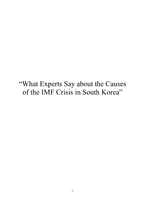
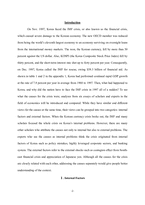

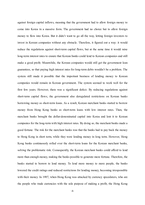
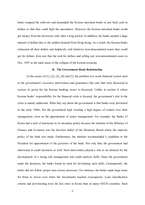
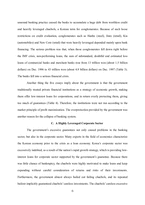
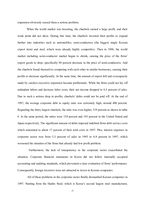
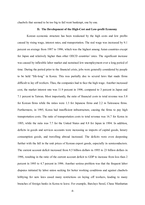
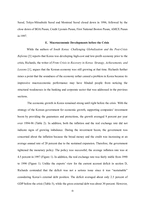
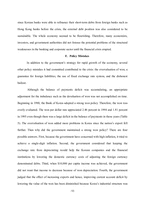

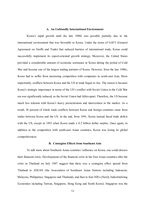
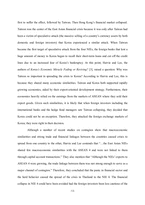
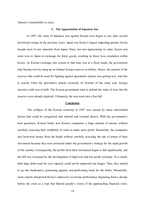
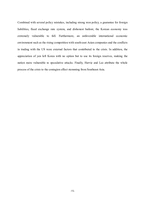
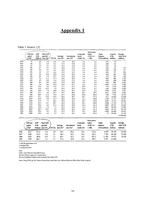
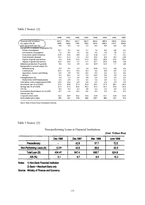

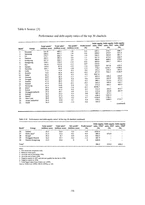
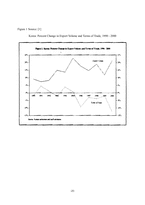
 분야
분야


